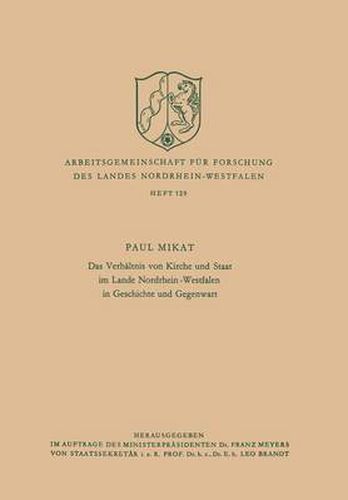Readings Newsletter
Become a Readings Member to make your shopping experience even easier.
Sign in or sign up for free!
You’re not far away from qualifying for FREE standard shipping within Australia
You’ve qualified for FREE standard shipping within Australia
The cart is loading…






This title is printed to order. This book may have been self-published. If so, we cannot guarantee the quality of the content. In the main most books will have gone through the editing process however some may not. We therefore suggest that you be aware of this before ordering this book. If in doubt check either the author or publisher’s details as we are unable to accept any returns unless they are faulty. Please contact us if you have any questions.
Within the Federal Republic of Germany, the relationship between Church and State comes principally under the responsibilities of the various Lan- der . In accordance with Federal Law, the Basic Law provides only a frame- work which, above all, guarantees the religious freedom of the individual and the right of self-determination of the Churches. The national ecclesias- ticallegal order, which is thus the responsibility of the Lander, is in many ways based upon history. The national ecclesiastical legal conditions have developed differently in the various territories of the Rhenish-Westphalian area since the Religious Peace of Augsburg (1555) and the Treaty of West- phalia (1648), upon the foundation of the religious powers of the rulers of these territories. The ecclesiastical rulers in the Archbishopric of Cologne and the Bisbopries of Munster and Paderborn were confronted with the case of Cleve-Mark, which feil to the lot of reformed Brandenburg in 1614. Inter- posed was the area of Julich-Berg which belonged to Catholic Pfalz-Neu- burg. In many cases conflicts arose from the claim of the ecclesiastics to jurisdiction over secular rulers. However, they also led to agreements which may be regarded as the precursors of the modern ecclesiastical agreements, adopting at an early date the ideals of tolerance and parity. The Reformed Church and Lutheran parish communities, which had arisen in all territories since the Reformation, united themselves in general Synods, which formed an all-embracing spiritual link between the different territories.
$9.00 standard shipping within Australia
FREE standard shipping within Australia for orders over $100.00
Express & International shipping calculated at checkout
This title is printed to order. This book may have been self-published. If so, we cannot guarantee the quality of the content. In the main most books will have gone through the editing process however some may not. We therefore suggest that you be aware of this before ordering this book. If in doubt check either the author or publisher’s details as we are unable to accept any returns unless they are faulty. Please contact us if you have any questions.
Within the Federal Republic of Germany, the relationship between Church and State comes principally under the responsibilities of the various Lan- der . In accordance with Federal Law, the Basic Law provides only a frame- work which, above all, guarantees the religious freedom of the individual and the right of self-determination of the Churches. The national ecclesias- ticallegal order, which is thus the responsibility of the Lander, is in many ways based upon history. The national ecclesiastical legal conditions have developed differently in the various territories of the Rhenish-Westphalian area since the Religious Peace of Augsburg (1555) and the Treaty of West- phalia (1648), upon the foundation of the religious powers of the rulers of these territories. The ecclesiastical rulers in the Archbishopric of Cologne and the Bisbopries of Munster and Paderborn were confronted with the case of Cleve-Mark, which feil to the lot of reformed Brandenburg in 1614. Inter- posed was the area of Julich-Berg which belonged to Catholic Pfalz-Neu- burg. In many cases conflicts arose from the claim of the ecclesiastics to jurisdiction over secular rulers. However, they also led to agreements which may be regarded as the precursors of the modern ecclesiastical agreements, adopting at an early date the ideals of tolerance and parity. The Reformed Church and Lutheran parish communities, which had arisen in all territories since the Reformation, united themselves in general Synods, which formed an all-embracing spiritual link between the different territories.